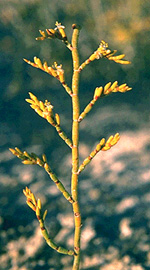 |
This small, cosmopolitan family is represented in Australia by a few species of salt-tolerant herbs or shrubs, found in many dry areas and around the coasts.
Characteristic features of the family Plumbaginaceae in Australia include: - herbs or small shrubs with leaves cauline and alternate or sometimes in a basal rosette, often covered with small glands
- flowers with an often papery and colourful calyx-tube formed from 5 fused sepals, and 5 free or fused petals that are spirally overlapped (convolute) in bud
- ovary superior with 1 or 5 styles, developing into a small, dry, indehiscent fruit enclosed in the persistent calyx
Description
Evergreen shrubs, or woody or herbaceous scrambling vines, or annual or perennial terrestrial herbs. Perennating by taproots or crowns. Vegetative reproduction absent or by rhizomes or stolons. Leaves sometimes ±absent; the stems succulent or not. Stem nodes conspicuously swollen or not; internodes spongy or pithy, terete, oval, slightly or strongly flattened. Internal secretions not obvious. Plants glabrous, or with simple, clavate, capitate or vesicular glandular or non-glandular, unicellular, uniseriate or multiseriate hairs. Leaves well developed or much reduced (i.e. to scales, etc.), alternate and spiral, or if herbs then the leaves cauline, all or mostly basal, or both basal and cauline, petiolate, subsessile or sessile. Stipules absent. Lamina simple, symmetric, pinnatifid or pinnatisect; lanceolate, ovate, elliptic, oblanceolate, ovate, oblong, spathulate or orbicular; base cuneate, attenuate, rounded, hastate or sagittate; margins entire, crenate, dentate or sinuate, ±flat; venation pinnate with the midrib conspicuous and the tertiary venation not reticulate; surfaces not punctate; herbaceous or leathery. All the flowers bisexual. Inflorescences terminal or axillary, consisting of capitula, spikes, racemes, panicles, monochasial cymes or solitary flowers. Bracts and bracteoles present. Pollination by insects. Flowers odourless, sessile or stalked. Perianth regular, of 2 dissimilar whorls, imbricate in bud. Calyx segments fused, with 5 or apparently 0 lobes; calyx tubular or salver-shaped, papery or membranous; base with wings or other appendages or without appendages. Corolla segments fused, with 5 or apparently 10 lobes, alternating with the calyx lobes; corolla funnel-shaped, salver-shaped or tubular, white, cream, yellow, pink, magenta, purple, violet or blue, without contrasting markings, membranous; claws absent; lobes ±entire or notched, emarginate, bifid or bilobed. Fertile stamens 5, opposite to the calyx lobes, at least partly fused to the corolla, free of the ovary and style, distinct from each other or fused by their filaments into an open or closed tube, all ±equal. Anthers basifixed, not versatile, opening sideways or inwards by longitudinal slits, 2-celled. Ovary superior and sessile. Carpels 5, fused; ovary with 1 locule. Style terminal, single and branched above or from the base. Ovule 1, stalked; placentation basal. Fruit a dry, dehiscent circumscissile or denticidal capsule, or an indehiscent achene or nut; the perianth on the maturing fruit dry and persistent. Disseminule macro-surface featureless or costate, brown, dull. Seeds 1 per fruit. Aril absent. Cotyledons 2. Embryo straight.
(Note: this description has been generated from the coded data compiled for the key. Any errors in the key data will be reflected in the descriptions.)
A treatment of the family Plumbaginaceae has not yet been published in the Flora of Australia. It will appear in Volume 5.
Australian genera of Plumbaginaceae (as recognised for the
Flora of Australia)
† = some species native, others introduced
Aegialitis
†Limonium
Plumbago
Muellerolimon

|
  |

Limonium (flowering plant)
Photo: S.Jacobs © S.Jacobs

Limonium sinuatum (flowers)
Photo: S.Jacobs © S.Jacobs

Muellerolimon salicorniaceum (flowers)
Photo: A.S.George © A.S.George

Plumbago zeylanica (flowers)
Photo: M.Fagg © M.Fagg
|
 |
|